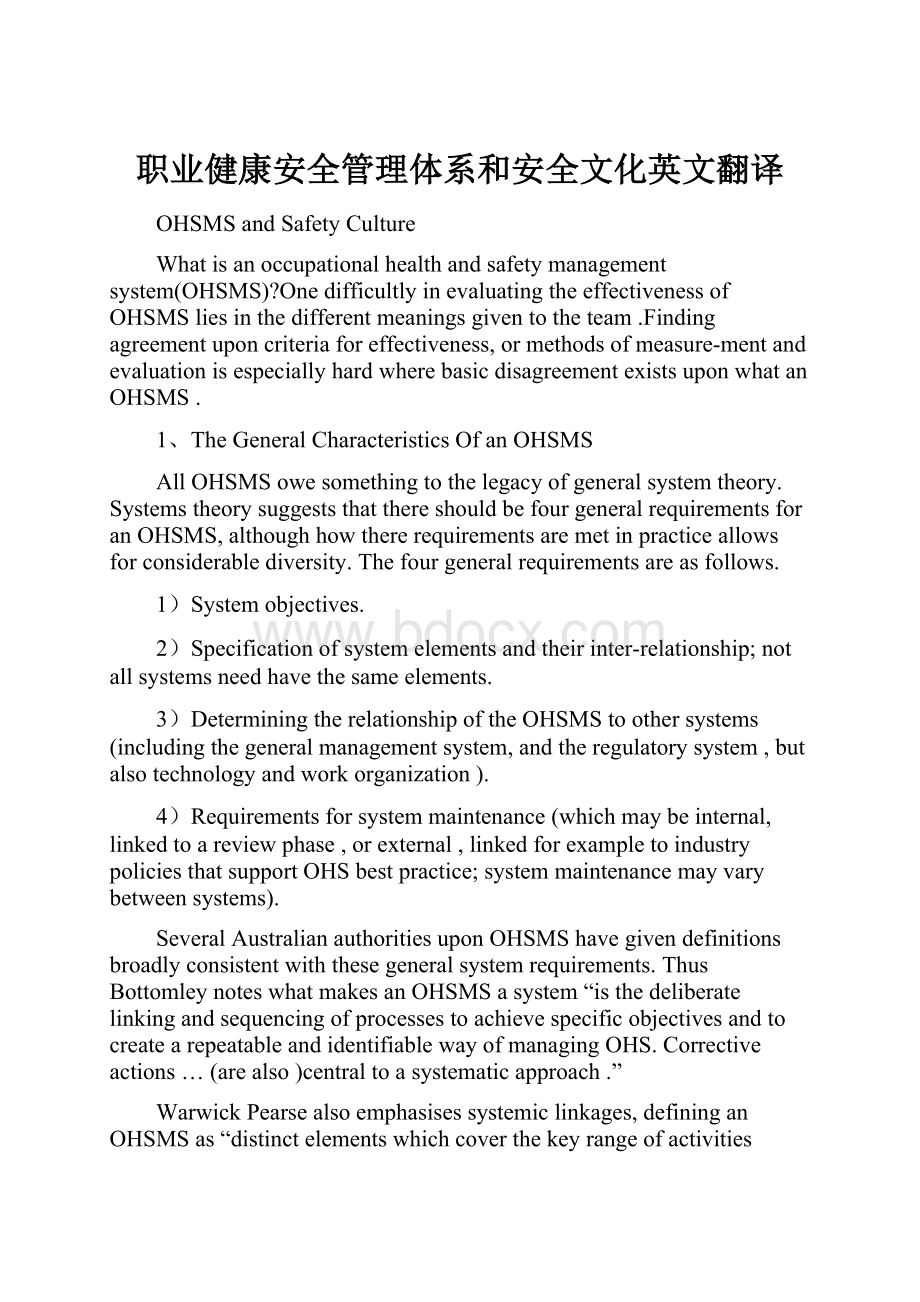职业健康安全管理体系和安全文化英文翻译.docx
《职业健康安全管理体系和安全文化英文翻译.docx》由会员分享,可在线阅读,更多相关《职业健康安全管理体系和安全文化英文翻译.docx(18页珍藏版)》请在冰豆网上搜索。

职业健康安全管理体系和安全文化英文翻译
OHSMSandSafetyCulture
Whatisanoccupationalhealthandsafetymanagementsystem(OHSMS)?
OnedifficultlyinevaluatingtheeffectivenessofOHSMSliesinthedifferentmeaningsgiventotheteam.Findingagreementuponcriteriaforeffectiveness,ormethodsofmeasure-mentandevaluationisespeciallyhardwherebasicdisagreementexistsuponwhatanOHSMS.
1、TheGeneralCharacteristicsOfanOHSMS
AllOHSMSowesomethingtothelegacyofgeneralsystemtheory.SystemstheorysuggeststhatthereshouldbefourgeneralrequirementsforanOHSMS,althoughhowthererequirementsaremetinpracticeallowsforconsiderablediversity.Thefourgeneralrequirementsareasfollows.
1)Systemobjectives.
2)Specificationofsystemelementsandtheirinter-relationship;notallsystemsneedhavethesameelements.
3)DeterminingtherelationshipoftheOHSMStoothersystems(includingthegeneralmanagementsystem,andtheregulatorysystem,butalsotechnologyandworkorganization).
4)Requirementsforsystemmaintenance(whichmaybeinternal,linkedtoareviewphase,orexternal,linkedforexampletoindustrypoliciesthatsupportOHSbestpractice;systemmaintenancemayvarybetweensystems).
SeveralAustralianauthoritiesuponOHSMShavegivendefinitionsbroadlyconsistentwiththesegeneralsystemrequirements.ThusBottomleynoteswhatmakesanOHSMSasystem“isthedeliberatelinkingandsequencingofprocessestoachievespecificobjectivesandtocreatearepeatableandidentifiablewayofmanagingOHS.Correctiveactions…(arealso)centraltoasystematicapproach.”
WarwickPearsealsoemphasisessystemiclinkages,defininganOHSMSas“distinctelementswhichcoverthekeyrangeofactivitiesrequiredtomanageoccupationalhealthandsafety.Theseareinter-linked,andthewholethingisdrivenbyfeedbackloops.”
Similarly,GallagherdefinesanOHSMSas“…acombinationoftheplanningandreview,themanagementorganizationarrangements,theconsultativearrangements,andthespecificprogramelementsthatworktogetherinanintegratedwaytoimprovehealthandsafetyperformance.”
2、VoluntaryOrMandatoryImplementationMethods
OnewaythatOHSMSdifferarisesfromthevariousmethodsofimplementation.FrickandWrendistinguishthreetypes—voluntary,mandatoryandhybird.VoluntarysystemsexistwhereenterprisesadoptOHSMSontheirowevolition.Oftenthisistoimplementstrategicobjectivesrelatingtoemployeewelfareorgoodcorporatecitizenship,althoughtheremaybeothermotivessuchasreducinginsurancecosts.Incontrast,mandatorysystemshaveevolvedinanumberofEuropeancountrieswherelegislationrequiresadoptionofariskassessmentsystem.Quasimandatorymethodsmayalsoexistwhereexternalcommercialpressurestaketheplaceoflegislativerequirements.ThusmanybusinessesadoptOHSMStocomplywiththerequirementsofcustomersandsuppliers,principalcontractorsandothercommercialbodies.Hybridmethodsaresaidtoentailamixtureofvoluntarymotivesandlegislativerequirements.
3.ManagementSystemsorSystematicManagement
FollowingfromtheirdistinctionbetweenvoluntaryandmandatoryOHSMS,FrickandWrenalsoseparateoccupationalhealthandsafety“managementsystems”,andthe“managementsystems”ofoccupationalhealthandsafety.Specifically,theformerhavebeencharacterizedas:
market-based,promotedtypicallybyconsultingfirms,andwithusuallyhighlyformalizedprescriptionsonhowtointegrateOHSMwithinlargeandcomplexorganizationsandalsocomprehensivedemandsondocumentation.
This“managementsystems”frommustmeetstringentcriteria.Wheretheserequirementsofa“systems”arenotmet,thenthetermissaidtobeinapplicable.Ontheotherhand,“systematicmanagement”isdescribedas“…alimitednumberofmandatedprinciplesforasystematicmanagementofOHS,applicabletoalltypesofemployersincludingthesmallones”.
ThisapproachstemsfrommethodsofregulationfoundinEuropeaswellasAustralia,wherebusinesses,includingsmallerones,areencouragedorrequiredtocomplywithalessdemandingframeworkthan“managementsystems”.Oneexampleofthissimplerregulatoryframeworkmightbetheriskassessmentprincipleswithinthe1989/391EuropeanUnionFrameworkDirective.
SupportforsuchalooseapproachtoOHSMalsoexistsinAustralia.OneemployerexpertonOHSdefinedsystemssimplyas“justawordforwhatyoudotomanagesafety”.ConsistentwiththisisBottomley’sall-encompassingapproachwhichallowsthat“…anOHSMScanbesimpleorcomplex,itcanbehighlydocumentedorsparinglydescribed,anditcanbehomegrownorbasedonanavailablemodel”.Anexampleofarelativelysimple“systematic”approachtothemanagementofoccupationalhealthandsafetyistobefoundin“SmallBusinessSafetySolutions”-abookletforsmallbusinesspublishedbytheAustralianChamberofCommerceandIndustry.
Thisadvocatesafourstepprocessasfollows:
Step1:
CommitmenttoaSafeWorkplace(framingapolicybasedonconsultation).
Step2:
RecognisingandRemovingDangers(usingadangeridentificationlist)
Step3:
MaintainingaSafeWorkplace(includingsafetychecks,maintenance,reportingdangers,informationandtraining,supervision,accidentinvestigation,andemergencyplanning).
Step4:
SafetyRecordsandInformation(includingrecordsandstandardsrequiredtobekeptbylaw)
Itisdebatablewhethersuchaframeworkfor“systematicmanagement”inasmallbusinesscanincludealltheelementsofplanningandaccountabilitythatareessentialtoa“managementsystem”inalargebusiness.
4.SystemCharacteristics:
managerialistandParticipativeModels
Within“managementsystems”twodifferentmodelscanbefound.ThefirstvariantstemsfromwhatNielsenterms“rationalorganisationtheory”(Tayloristandbureaucraticmodelsoforganisation).RationalorganisationtheoryisassociatedwithtopdownmanagerialistmodelsofOHSMSsuchasDuPont.Someauthoritiesnowconsidermostvoluntarysystemstobemanagerialist.ThusFrick.etal.observethat“...mostvoluntaryOHSMsystemsdefinetopmanagementasthe(oneandonly)actor”.Conversely,analternativeparticipativemodelof“managementsystems”canbetracedtosocio-technicalsystemstheory,whichemphasisesorganisationalinterventionsbasedonanalysisoftheinter-relationshipsoftechnology,theorientationofparticipants,andorganisationalstructure.
Thestrengthsofthistypologyaretwo-fold.First,itisgroundedintheliteraturethatdiscussesalternativeapproachestomanagingOHSanddifferentcontrolstrategies,anditreflectstheprincipaldebatesinthatliterature.Second,itcanbeoperationalisedthroughempiricalteststoseewhichtypeofOHSMSperformsbest.
Thetypologyalsofacesadifficultyinthefactthatthe“safeplacecontrolstrategy“ismandatoryinAustraliaandshouldbefoundinallworkplaces.Thereinnot,therefore.aclearchoicebetweentwomutuallyexclusivecontrolstrategies;theworkplacewithdominantsafepersoncharacteristicsshouldalsobeimplementingsafeplacecharacteristics.
5.DegreeofImplementation:
QualityLevels
FrickandWrenexpandupontheirdistinctionbetweenmandatoryandvoluntaryOHSMStofurtheridentifythreelevelsofsystemsobjectives,drawnfromtheliteratureonproductqualitycontrol,thatrepresentdifferentlevelsofachievementandmeasuresofOHSMperformance.
6.degreeofImplementation:
IntroductoryandAdvancedSystems
TheideathattheremaybedifferentlevelsofOHSMhasbeeninterpretedanotherwayinAustraliawhereperformanceleversinsomeprogramsareexplicitlydevelopmental(thebusinessgraduatingupanascendingladderasitdemonstratescompliancewiththerequirementsofeachsuccessivelever).
OneexampleofAustralianprogramwithdevelopmentalstepsistheSouthAustralianSafetyAchieverBusinessSystem(SABS)(formerlyknownastheSafetyAchieverBonusScheme).Theprogramspecifiesfivestandards(commitmentandpolicy,planningimplementation,measurementandmanagementsystemsreviewandimplementation)linkedinacontinuousimprovementcycle.Three“levels”ofimplementationarethenprescribedcumulativelyintroducingallfivestandardsfromabasicorintroductoryprogramtoacontinuousimprovementsystem.Differentevaluationstandardsareprescribedforeachlevel.
7.OHSMSDiversityandEvaluation:
ASummary
While,ingeneral,thisReportadvocatescareindefiningOHSMSwithrespecttotheproblemsoutlinedabove,forthepurposeofthisprojectaninclusiveapproachtothephenomenaistobeadopted.Inparticular,thetermOHSMSwillbeusedbroadlytoencompassboththehighlycomplexformalsystemsadoptedvoluntarilybysomebusinessesaswellasthemorerudimentarymandatoryoradvisoryframeworksofferedtoandimplementedbysmallbusiness.
Sofar,wehaveshownthatOHSMScanvaryuponanumberofdimensionsrelatingtomethodofimplementation,systemcharacteristics,anddegreeofimplementation.SuchvarianceisimportantbecauseitaffectsevaluationandmeasurementofOHSMSperformance.Measuresappropriateforonedimensionofasystemwillbeirrelevanttoanother.EvaluationofOHSMSeffectivenessmayneedtotakeaccountofwhatsystemsareexpectedtodo.Aretheytomeetcomplexsystemorsimpledesignstandards?
AretheyimplementedatthebehestofmanagementorexternalOHSauthorities?
Areobjectivesthesimpleonessuchasreducingdirectlost-timeinjuriesordotheyincludesatisfyingmultiplestakeholders?
Aretheyatanearlyorestablishedstageofdevelopment;andwhichofseveraldifferentconfigurationsofcontrolstrategyandmanagementstructure/styleisadopted?
Drawi